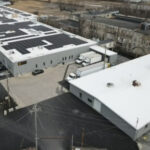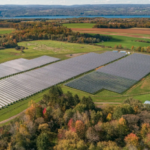The number of workers in the solar industry has grown rapidly over the last decade. The Solar Foundation’s National Solar Jobs Census found that the industry added over 51,000 jobs in 2016 alone, finishing the year with a total of over 260,000 solar workers nationwide. One out of every 50 new U.S. jobs came from the solar industry in 2016, with 44 of the 50 states increasing the size of their solar workforce. This massive influx of new workers has created strong demand for education and training.
“If building designers and installers can better understand solar, batteries, code, and other industry topics, we can keep solar installers busy and profitable.” – John Cromer, Community.Solar
Enter John-Ross Cromer, who is an Ivy League mechanical engineer, master electrician, NABCEP-certified PV installer, and author of Solar Power Design and Development: An Introduction to Rooftop Solar. Since 2008, he’s made it his business to train and educate professionals all over the country on solar energy. Mr. Cromer brings ten years of solar project experience including residential, commercial, and small utility-scale projects. Today, Mr. Cromer is the Course Author and Lead Instructor at Community.Solar, where he teaches classes to engineers, architects, and construction managers. Lately, he’s been targeting the NABCEP community, combining all of Community Solar’s programs into The Glass-Slappers Guide to Solar Power, which meets 100% of most NABCEP PV recertification requirements.
Mr. Cromer uses Energy Toolbase, as well as a few other software tools as part of his course training curriculum. We recently caught up with Mr. Cromer to get his perspective on a few topics he sees on the front-lines of training and educating the solar industry.
Please tell us a little about Community.Solar, including its mission and impact?
Community.Solar focuses on providing affordable solar training and continuing education using lessons learned as a NABCEP PV installer. Solar and other renewables have such promise that we can’t imagine what our electric grid will look like in 20 or 30 years. In the process of training and education, we also fight against industry wrongs and barriers to entry in solar all over the globe.
What motivated you to get into the solar business?
I originally came from the oil industry. I got into solar understanding my employer viewed solar as a competitive threat in 2005, because of how disruptive it could be to the energy sector. I saw an opportunity to master solar design skills when few engineers were in the industry. The background helps me teach solar in terms that more conservatively-minded project managers can accept.
What are some challenges that you’ve seen project developers, engineers and architects who are new to the field encounter?
It’s always a fun challenge to field sharp-shooter questions from a technical audience. A better understanding of code and design can lead to design innovation. We need more professionals in the industry, and we want our audience members to trust their technical backgrounds if they identify a solar industry practice that rings alarm bells. There’s always going to be some resistance to change is real. Some engineers and project managers still view solar as green technology for hippies, when in fact, solar has never been more important to our energy sector.
Given that you’ve led educational programs in all 50 states, what are some trends you’ve noticed in different regional markets in the solar industry?
The hardest market for solar is where electricity price is low and backfed solar is not well valued. We cannot have an even playing field until all emissions are valued into the price of electricity. Traditional generators want to treat carbon dumping as a free lunch. The public should protest for better climate policy within regulated grids that lack consumer solar protections. The next step should be to educate them that solar can clean the environment without increasing the price of electricity.
The industry should look at where solar is cost-effective in unsubsidized markets to learn about where the market should be. Emerging markets will be based on more comprehensive energy management, which can be almost as cost-effective in Mississippi as in New York. Also, environmental devastation reminds us that we can’t ignore environmental policy. The upside of climate change is that it reduces resistance to local renewable mandates and increases public demand for distributed renewables. When fires, hurricanes, and record temperatures fill the news, it chips away at the number of Americans who think solar is for other people.
How has Energy Toolbase benefited your educational programs?
Energy Toolbase is the best software on the market for evaluating batteries and energy storage systems. It provides clarity, accuracy, and transparency. I don’t think it’s possible to model solar battery value better than Energy Toolbase, nor automate economic modeling to a degree of accuracy that will make a CFO smile. We use Energy Toolbase to illustrate design concepts in class which helps audience members identify new work opportunities. Batteries are obviously the next big thing for the industry. There’s already a lot of demand for training and education on the topic, and I expect that to increase. I’m especially optimistic about residential battery retrofits, which will be a good opportunity for solar installers to go back to their existing installed network of customers.
How does Community.Solar update its training and educational curriculum in such a rapidly evolving industry? And what can solar companies do to ensure they stay current and competitive?
Trainers and educators like Community.Solar need to keep our classes updated, technical, and affordable focusing on real industry topics while encouraging audience networking. We want our audience to be able to implement the concepts taught in class to increase their project work. There is still fruit on the tree for solar companies, they just have to be smart about soft cost reduction. Architects and engineers could simplify the installation by doing more on the front-end design. Solar installers can collaborate with mainstream craft to reduce labor cost without sacrificing their own value as site supervisors and foremen.
What are the core takeaways you hope your students leave your classes knowing?
Don’t be afraid to learn about electricity. I didn’t fully understand voltage until I started studying for the master electrician exam. Fundamentally, it’s big energy that fears consumer solar, and solar design is more accessible than other forms of electric power. Also, I would also like to thank anyone taking a renewable program for being part of the movement. Not everyone in class is thinking about a career change, but we need every voice to proselytize. I’ve met college professors who think the theoretical efficiency of solar is 8% and hotel clerks who know more about lithium ion retrofits than most NABCEP PV installers. Going 100% renewable is a team effort, and we need the largest team possible.




